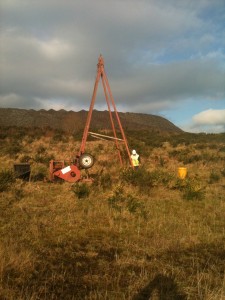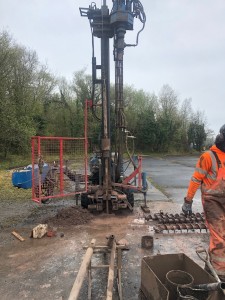Site Investigation – Geotechnical
We can offer the following intrusive site investigation techniques. The site investigation data can be presented as either factual or interpretive reports relating to both geotechnical and/or environmental considerations. Site Investigation data can be provided in AGS format with the report supplied in PDF format on CD.
Trial Pitting
Trial pitting can be carried out by a variety of methods from hand dug pits to machine excavated trenches. Trial pitting is generally carried out to a maximum depth of 4.5m with standard excavation plant and, depending on soil conditions, is generally suitable for most low rise developments. All trial pit investigations are supervised by experienced engineers with a thorough understanding of geology and soil mechanics.
Additional testing in trial pits can include soak-away testing, hand vanes, CBR testing and in-situ strength testing.
Slit Trenching
Slit trenches can be carried out by a variety of methods from hand dug pits to machine excavated trenches. Slit trenching is generally carried out to a depth of 1.5m with small excavation plant. Their purpose is to locate and record the exact position of existing underground services owned by utility companies.
Window Sampling and Dynamic Probing
Our tracked mounted window sampling rigs are used to sink boreholes up to 125mm diameter through a variety of soil types. These rigs are mainly used for shallow site investigations to assess the type, relative density or strength of the ground to depths of 10m. In-situ testing using the standard penetration test or the super heavy dynamic probe can both be carried out. The rig consists of a mechanized drop-weight that repeatedly falls onto an anvil forcing an attached sampling tube or probe rod into the ground. After driving the sampler or probing rod to the required depth they are extracted using a hydraulic ram. The window sample tube consists of a steel tube incorporating a longitudinal slot or “window” along one side, through which soil samples can be removed. These soil samples are disturbed during the removal process, however undisturbed U100 samples can be taken at shallow depths.
When using the same rig for environmental testing a windowless sample tube is used. The sampler tube does not have the open window section. Samples are retrieved within a seamless plastic liner which greatly facilitates the handling, presentation and preservation of the soil samples for logging by a suitably qualified engineer. The samples obtained are classified as being disturbed due to the driving process, however, the plastic liner greatly reduces the possibility of cross contamination between successive samples.
Window sampling is particularly suited to restricted access sites, contamination investigations, and where disturbance of the existing ground surface must be kept to a minimum. The compactness and weight of the window sampling rig means that it is also capable of being carried or lifted into position using suitable hydraulic excavators or cranes.

Cable Percussive Boreholes
Suitable for most projects, cable percussive boreholes are a common method of site investigation down to rock head. Using a land rover towed rig or a specialist cut down rig suited to restricted access locations most sites can be investigated. In-situ testing techniques including Standard Penetration Testing, Permeability Testing and Borehole Vane Testing can all be carried out in the boreholes in order to provide information for geotechnical design. Disturbed and undisturbed (U100 or thin walled piston) samples are retrieved from the boreholes for inspection and logging by engineers and subsequent testing in our laboratories. We can provide for various borehole diameters with or standard diameter being 200mm.
Rotary Boreholes
Rotary drilling techniques are employed where boreholes are required into overburden or bedrock. Two different techniques are used depending on the required outcome. If all that is required for the client is a hole in the ground then rotary drilling without core recovery will be undertaken using either down the hole hammer or symmetrix techniques. The hammer is a rotary percussive technique which uses air flush and normally no casing. The symmetrix system has the advantage of casing the hole as the hammer progresses due to the locking of the drilling bit into the casing bit. Air flush is also used. If information on bedrock is required then rotary coring with core recovery can be utilized. This produces samples of bedrock which are recovered in seamless plastic tubes for subsequent logging by a suitably qualified engineering geologist and for laboratory testing. Core size are dependent on the clients requirements.